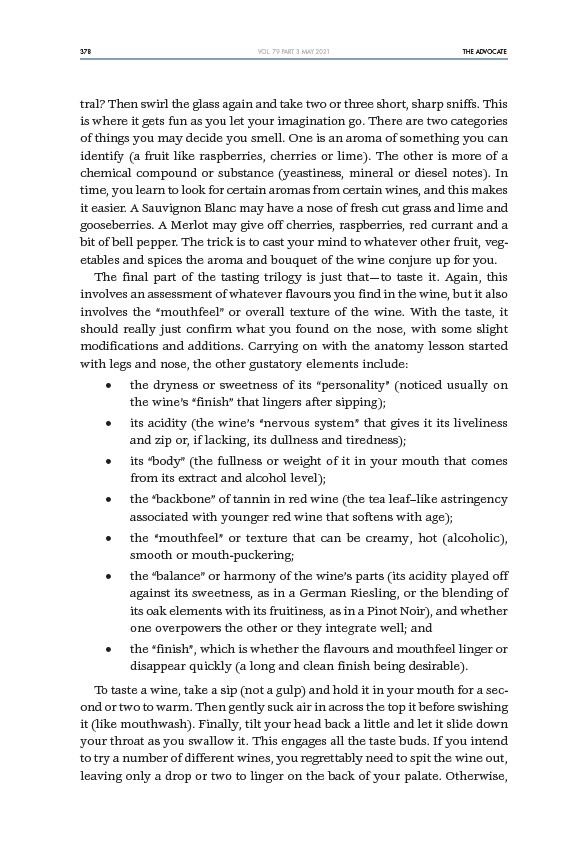
378 THE ADVOCATE
VOL. 79 PART 3 MAY 2021
tral? Then swirl the glass again and take two or three short, sharp sniffs. This
is where it gets fun as you let your imagination go. There are two categories
of things you may decide you smell. One is an aroma of something you can
identify (a fruit like raspberries, cherries or lime). The other is more of a
chemical compound or substance (yeastiness, mineral or diesel notes). In
time, you learn to look for certain aromas from certain wines, and this makes
it easier. A Sauvignon Blanc may have a nose of fresh cut grass and lime and
gooseberries. A Merlot may give off cherries, raspberries, red currant and a
bit of bell pepper. The trick is to cast your mind to whatever other fruit, vegetables
and spices the aroma and bouquet of the wine conjure up for you.
The final part of the tasting trilogy is just that—to taste it. Again, this
involves an assessment of whatever flavours you find in the wine, but it also
involves the “mouthfeel” or overall texture of the wine. With the taste, it
should really just confirm what you found on the nose, with some slight
modifications and additions. Carrying on with the anatomy lesson started
with legs and nose, the other gustatory elements include:
• the dryness or sweetness of its “personality” (noticed usually on
the wine’s “finish” that lingers after sipping);
• its acidity (the wine’s “nervous system” that gives it its liveliness
and zip or, if lacking, its dullness and tiredness);
• its “body” (the fullness or weight of it in your mouth that comes
from its extract and alcohol level);
• the “backbone” of tannin in red wine (the tea leaf–like astringency
associated with younger red wine that softens with age);
• the “mouthfeel” or texture that can be creamy, hot (alcoholic),
smooth or mouth-puckering;
• the “balance” or harmony of the wine’s parts (its acidity played off
against its sweetness, as in a German Riesling, or the blending of
its oak elements with its fruitiness, as in a Pinot Noir), and whether
one overpowers the other or they integrate well; and
• the “finish”, which is whether the flavours and mouthfeel linger or
disappear quickly (a long and clean finish being desirable).
To taste a wine, take a sip (not a gulp) and hold it in your mouth for a second
or two to warm. Then gently suck air in across the top it before swishing
it (like mouthwash). Finally, tilt your head back a little and let it slide down
your throat as you swallow it. This engages all the taste buds. If you intend
to try a number of different wines, you regrettably need to spit the wine out,
leaving only a drop or two to linger on the back of your palate. Otherwise,